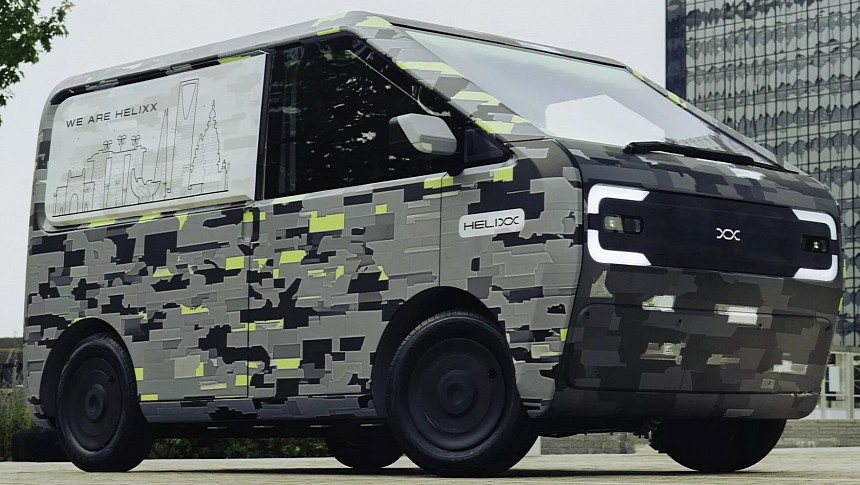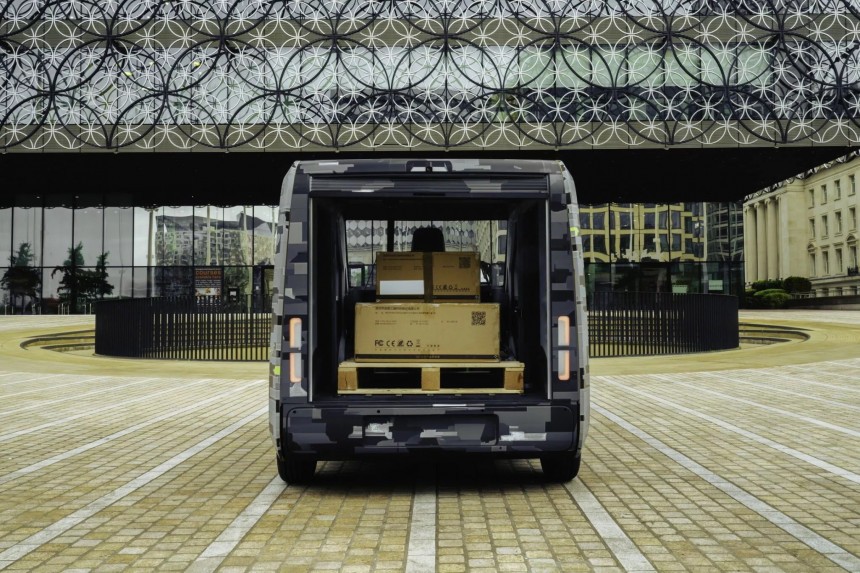The development of electric vehicles continues to expand, and carmakers are adopting new approaches to EV manufacturing in an attempt to accelerate the future of mobility. Earlier this year, UK-based startup Helixx presented an innovative manufacturing process that relies on the "factory in a box" concept. This new process would enable the creation of modular, local micro-factories to assemble smaller, low-cost electric vehicles anywhere in the world.
Now, the British global technology company has unveiled a prototype of one of its tiny electric vehicles - the Helixx Cargo - proving its manufacturing process is effective and could pave the way for a greener, more accessible future.
The demonstrator vehicle previews the company's commercial delivery van, which boasts a minimalist aesthetic and compact dimensions. But the highlight of the new electric vehicle is its unusual modular design. The body of the Helixx Cargo van is made entirely of recycled polymer and comprises only five individual parts that "click and bond" together like Lego pieces to form a unified structure.
The effortless assembly significantly simplifies the manufacturing process and reduces car production costs, as it avoids the use of expensive, carbon-intensive steel. At the same time, the company claims it results in a robust and highly durable vehicle.
Through the successful construction of this prototype, Helixx has essentially achieved its goal of realizing a "first-time-fit” during the bonding process, and this makes it possible to abandon stamped metal body panels and avoid the use of complex welding, which is known to generate CO2 and consume a lot of electrical energy in the process.
The company used in-house 3D printing to create the body parts, and all the components were captured digitally using software developed by industry-leading Siemens.
The greatly simplified body system leads to a lighter vehicle, with 30% less mass and way fewer individual components than conventionally built vehicles, which falls in line with the company's ambition of establishing an entirely new vehicle category.
"We developed this demonstration vehicle to prove and stress-test the global replicability of our digital-first approach," Helixx CEO Steve Pegg explained. "The vehicle visually represents what licensed Helixx Mobility Hubs can produce in as little as 180 days from initial site survey to vehicles rolling out onto the street."
The Helixx Cargo electric van is also designed for optimum interior load space to respond to the needs of both manufacturers and fleet operators. Built around a hybrid aluminum chassis, it offers 2,100 liters (74 cubic feet) of storage capacity and a 1,102-pound (500 kg) maximum payload.
The van's body measures 10.5 feet (3.2 meters) in length and 4.9 feet (1.5 meters) in width, with a 43.3-inch (110-cm) wide rear door and 55 inches (140 cm) of load space, meaning it can accommodate the majority of global shipping pallets. Compact headlights and C-shaped daytime running lights can be seen at the front of the vehicle, while at the rear, there are vertical separate lights.
Another distinctive feature of the Cargo van is the central driving position. The EV has a single seat in the middle of the cabin, a design choice meant to optimize load space and ensure compatibility in both left- and right-hand-drive countries.
The vehicle's powertrain will be powered by a removable LFP (lithium-iron-phosphate) battery, which, according to Helixx, is designed to allow the van to operate continuously for 24 hours.
Besides the Cargo electric van, Helixx will also produce a pick-up truck, an open-body, and a closed-body passenger vehicle based on the same platform, all of them intended for use in busy cities and developing economies around the world. Once built, it will offer the Cargo and the other versions of its vehicle via subscription with an operating cost of US$0.25 per hour.
Helixx's plan going forward is to show off its demonstrator vehicle and ask for feedback on the design before starting a limited production run of 100 vehicles at a pilot facility in the UK. If everything goes to plan, it will eventually begin customer vehicle and factory rollout at a concept hub in Southeast Asia.
The demonstrator vehicle previews the company's commercial delivery van, which boasts a minimalist aesthetic and compact dimensions. But the highlight of the new electric vehicle is its unusual modular design. The body of the Helixx Cargo van is made entirely of recycled polymer and comprises only five individual parts that "click and bond" together like Lego pieces to form a unified structure.
The effortless assembly significantly simplifies the manufacturing process and reduces car production costs, as it avoids the use of expensive, carbon-intensive steel. At the same time, the company claims it results in a robust and highly durable vehicle.
Through the successful construction of this prototype, Helixx has essentially achieved its goal of realizing a "first-time-fit” during the bonding process, and this makes it possible to abandon stamped metal body panels and avoid the use of complex welding, which is known to generate CO2 and consume a lot of electrical energy in the process.
The company used in-house 3D printing to create the body parts, and all the components were captured digitally using software developed by industry-leading Siemens.
"We developed this demonstration vehicle to prove and stress-test the global replicability of our digital-first approach," Helixx CEO Steve Pegg explained. "The vehicle visually represents what licensed Helixx Mobility Hubs can produce in as little as 180 days from initial site survey to vehicles rolling out onto the street."
The Helixx Cargo electric van is also designed for optimum interior load space to respond to the needs of both manufacturers and fleet operators. Built around a hybrid aluminum chassis, it offers 2,100 liters (74 cubic feet) of storage capacity and a 1,102-pound (500 kg) maximum payload.
The van's body measures 10.5 feet (3.2 meters) in length and 4.9 feet (1.5 meters) in width, with a 43.3-inch (110-cm) wide rear door and 55 inches (140 cm) of load space, meaning it can accommodate the majority of global shipping pallets. Compact headlights and C-shaped daytime running lights can be seen at the front of the vehicle, while at the rear, there are vertical separate lights.
Another distinctive feature of the Cargo van is the central driving position. The EV has a single seat in the middle of the cabin, a design choice meant to optimize load space and ensure compatibility in both left- and right-hand-drive countries.
The vehicle's powertrain will be powered by a removable LFP (lithium-iron-phosphate) battery, which, according to Helixx, is designed to allow the van to operate continuously for 24 hours.
Besides the Cargo electric van, Helixx will also produce a pick-up truck, an open-body, and a closed-body passenger vehicle based on the same platform, all of them intended for use in busy cities and developing economies around the world. Once built, it will offer the Cargo and the other versions of its vehicle via subscription with an operating cost of US$0.25 per hour.
Helixx's plan going forward is to show off its demonstrator vehicle and ask for feedback on the design before starting a limited production run of 100 vehicles at a pilot facility in the UK. If everything goes to plan, it will eventually begin customer vehicle and factory rollout at a concept hub in Southeast Asia.



















